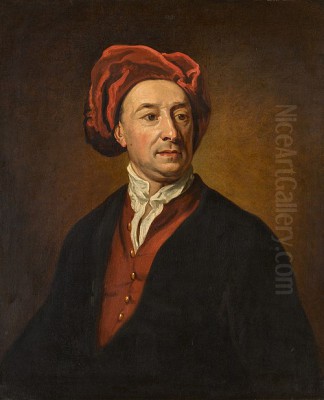
Jean-Baptiste Monnoyer stands as one of the most significant and accomplished flower painters of the French Baroque era. Active during the opulent reign of Louis XIV, the Sun King, Monnoyer's art perfectly captured the period's taste for grandeur, decorative richness, and a certain scientific curiosity about the natural world. Born with Flemish roots but flourishing in the heart of French artistic life, he specialized in still life paintings, particularly elaborate compositions of flowers and fruit, that adorned the grandest palaces and chateaux of France and, later, England. His work is characterized by a remarkable blend of botanical accuracy and lavish artistic arrangement, securing his place in the annals of art history.
From Lille to Paris: Early Life and Artistic Formation
Jean-Baptiste Monnoyer was born in Lille in 1636, a city that, while French at the time of his death, had strong historical and cultural ties to Flanders. This Franco-Flemish background likely played a role in his artistic development. Details of his earliest training are somewhat scarce, but it is widely believed that he travelled to Antwerp, a major artistic centre, particularly renowned for its still life tradition. There, he would have been exposed to the legacy of Flemish masters who excelled in depicting the natural world with meticulous detail and vibrant colour, such as Jan Brueghel the Elder and the Jesuit painter Daniel Seghers, famous for his flower cartouches.
Around 1650, Monnoyer made the pivotal move to Paris. This city was rapidly becoming the undisputed artistic capital of Europe under the ambitious cultural policies of the young Louis XIV and his ministers. Paris offered opportunities unavailable elsewhere, particularly the prospect of royal patronage and involvement in the large-scale decorative projects initiated by the crown. Monnoyer arrived at a time when French art was defining its own grand style, heavily influenced by Italian Baroque principles but adapted to French sensibilities under the guidance of figures like Charles Le Brun.
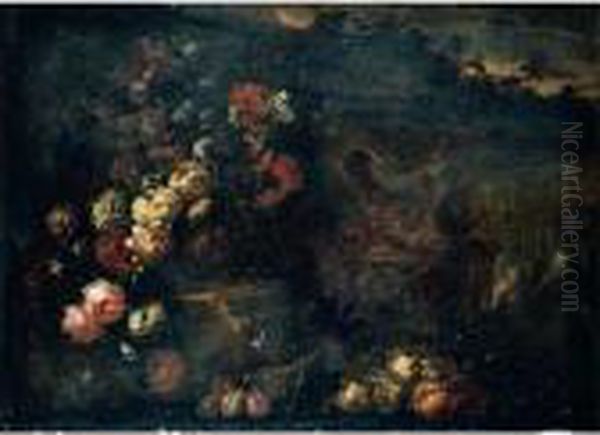
His talent must have been readily apparent. He quickly integrated into the Parisian art scene, focusing on the genre of still life, which, while considered lower in the official hierarchy of genres than history painting, was highly valued for decorative purposes. His ability to render flowers and fruit with both precision and a sense of abundant life set him apart.
Acceptance into the Academy and Royal Recognition
A significant milestone in Monnoyer's career occurred in 1665 when he was received (agréé) and then accepted as a full member (reçu) of the prestigious Académie Royale de Peinture et de Sculpture (Royal Academy of Painting and Sculpture). His reception piece, the painting now generally identified as Flowers and Fruit (Fleurs et Fruits, 1665), is a testament to his skill and ambition. This work, currently housed in the Musée Fabre in Montpellier, showcases his mastery of composition, colour, and texture, featuring a lavish arrangement of blooms and produce rendered with exquisite detail.
Membership in the Academy was crucial for any artist seeking high-level commissions in France. It placed Monnoyer within the official structure of French art, overseen by Charles Le Brun, the powerful Premier peintre du Roi (First Painter to the King). Le Brun orchestrated the vast decorative schemes for the royal palaces, and he recognized Monnoyer's specialized talent as invaluable for these projects. Monnoyer became one of the key artists employed to embellish the interiors of the King's residences.
His association with Le Brun and the Academy opened doors to the most important commissions of the era. He contributed decorative panels and paintings featuring his signature floral and fruit motifs to numerous royal and aristocratic residences, including the Château de Vincennes, the Château de Saint-Cloud, and, most famously, the Palace of Versailles.
The Art of the Flower: Style and Technique
Monnoyer's style is quintessentially Baroque, characterized by dynamism, richness, and a flair for the dramatic. His floral compositions are rarely simple bouquets; instead, they are often opulent, overflowing arrangements set against architectural backgrounds or luxurious fabrics. He combined a keen eye for botanical detail – contemporaries noted his ability to depict specific varieties of flowers accurately – with a powerful sense of design. His works achieve a balance between scientific observation and artistic license, creating displays that are both believable and breathtakingly beautiful.
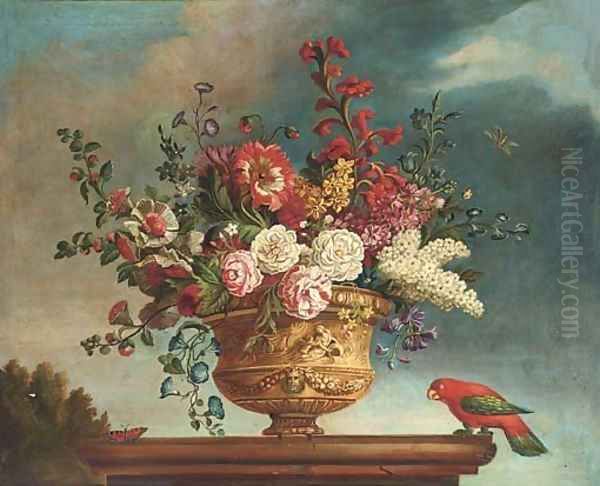
He painted a wide variety of flowers, often favouring popular blooms of the time like tulips (though past the peak of 'tulip mania', they remained prized), roses, poppies, peonies, carnations, anemones, hyacinths, and lilies. These were frequently combined with fruits such as grapes, peaches, plums, and melons, adding variety in form and texture. His compositions are typically complex, employing diagonal lines and contrasting light and shadow (chiaroscuro) to create depth and visual excitement. The arrangements often seem to spill out towards the viewer, enhancing the sense of abundance and immediacy.
Compared to some of his Dutch contemporaries, such as Jan Davidsz. de Heem or Rachel Ruysch, whose works often carried strong vanitas undertones (reminders of life's transience), Monnoyer's paintings generally emphasize decorative splendour and the celebration of nature's bounty, aligning perfectly with the luxurious tastes of the French court. While symbolism might be present, the overwhelming impression is one of magnificence and vitality. His palette is rich and vibrant, capturing the subtle gradations of colour in petals and leaves with remarkable sensitivity.
Grand Decorations: Versailles and Beyond
The reign of Louis XIV saw an unprecedented flourishing of the decorative arts in France, driven by the King's desire to create palaces that reflected his power and glory. Monnoyer played a significant role in these endeavours, working alongside architects like Louis Le Vau and Jules Hardouin-Mansart, garden designers like André Le Nôtre, and a host of painters and sculptors under the direction of Charles Le Brun.
At Versailles, Monnoyer contributed numerous overdoor panels and decorative paintings, often featuring flowers set in ornate vases or woven into garlands. These works were integral parts of the overall decorative schemes of the state apartments and private chambers, complementing the architecture, furniture, and tapestries. His ability to adapt his compositions to specific architectural settings – fitting flowers into lunettes, rectangular panels, or complex shapes – was highly valued.
Beyond Versailles, he received commissions for other significant locations. He worked at the Château de Marly, another royal retreat favoured by Louis XIV, and decorated private Parisian mansions (hôtels particuliers), such as the Hôtel de Lauzun, demonstrating that his appeal extended to the highest levels of the aristocracy. His paintings were sought after not just as wall decorations but also as independent easel paintings, collected by connoisseurs who appreciated his technical brilliance and aesthetic appeal.
Designs for Tapestry: Gobelins and Beauvais
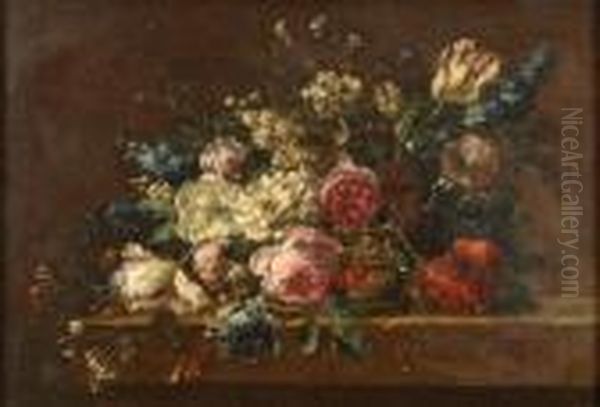
Monnoyer's contribution to the decorative arts extended beyond painting into the realm of tapestry design. He was frequently employed by the two leading French tapestry manufactories: the Manufacture des Gobelins in Paris (primarily serving the Crown) and the Manufacture de Beauvais (a private enterprise also enjoying royal favour). His role was typically to provide detailed paintings or drawings (cartoons) of flowers, fruits, and foliage that would be incorporated into larger tapestry designs by other artists.
He collaborated on several famous tapestry series. One notable example is The Grotesques, a series woven at Beauvais based on designs coordinated by Jean Bérain the Elder, a leading ornamental designer. Monnoyer likely provided the intricate floral and fruit elements that adorned these whimsical compositions, which often featured fantastical architecture, mythological figures, and exotic animals. His work needed to be clear and detailed enough for the weavers to translate accurately into thread.
Another significant project involved designs for the Beauvais series known as The Story of the Emperor of China. This set of tapestries, reflecting the period's fascination with the East (Chinoiserie), featured scenes of Chinese court life and landscapes. While artists like Guy-Louis Vernansal and Jean-Baptiste Belin de Fontenay (Monnoyer's son-in-law) are credited with the main figural compositions, Monnoyer is believed to have contributed the rich floral borders and botanical details that framed these exotic scenes, adding a layer of familiar European naturalism to the unfamiliar subject matter. His collaboration with Belin de Fontenay, another skilled flower painter, was particularly fruitful.
Masterpieces of Floral Painting
Several paintings stand out as representative of Monnoyer's oeuvre. His Academy reception piece, Flowers and Fruit (1665, Musée Fabre, Montpellier), remains a cornerstone for understanding his early mastery. It displays a confident handling of a complex arrangement, with light catching the textures of petals, leaves, and fruit skins, set against a dark background that makes the colours pop.
Another highly regarded work is Flowers, Fruits and Objects of Art (c. 1670s, Louvre Museum, Paris). This large and ambitious painting goes beyond simple floral depiction. It presents an opulent still life that includes not only flowers and fruit but also a sculpted vase, a carpet, and other luxurious objects. Some interpretations suggest allegorical meanings related to the arts, the senses, or the bounty of nature under wise rule, possibly hinting at the patronage of Louis XIV. The sheer complexity and richness of the composition are characteristic of his mature style.
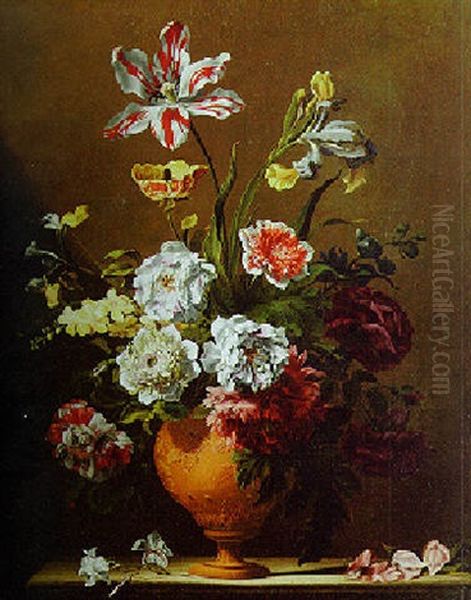
A painting like A Bouquet of Anemones, York- and Lancaster Roses and Other Flowers in a Sculpted Vase demonstrates his ability to focus on specific blooms while still creating a sense of luxurious abundance. The detailed rendering of the different rose varieties (the red Lancaster and the white York roses, symbols from English history, perhaps indicating a later work or one destined for an English patron) and the vibrant anemones showcases his botanical knowledge and painterly skill. The play of light on the sculpted vase adds another layer of texture and realism. These works, found in major museums like the Louvre, the Metropolitan Museum of Art, and national galleries worldwide, confirm his status.
The London Years and English Patronage
Towards the end of his career, around 1690, Monnoyer was invited to London. The invitation came from Ralph Montagu, 1st Duke of Montagu, who was the English ambassador to France and a great admirer of French arts and culture. Montagu was building a lavish residence, Montagu House, in Bloomsbury (on the site where the British Museum now stands) and wanted the finest French artists to decorate it. Monnoyer accepted the commission and spent the last years of his life primarily in England.
At Montagu House, he executed extensive decorative schemes, painting murals and panels filled with his signature floral compositions. His work was highly acclaimed in London and led to further commissions from the English nobility. He contributed decorations to other grand houses, including Boughton House (another Montagu property), Hampton Court Palace, and Kensington Palace, where he worked alongside other artists during the reigns of William III and Mary II. His presence in London significantly influenced English decorative painting and fostered a taste for elaborate floral still lifes among English patrons and artists. While England had its own traditions, Monnoyer brought a distinctly French Baroque grandeur. His contemporaries in England included portraitists like Sir Godfrey Kneller and Sir Peter Lely, but Monnoyer occupied a unique niche with his decorative specialisation.
He remained in London until his death in 1699. He was buried at St. James's Church, Piccadilly, a testament to his established position within London society. His English period represents an important chapter in his career, demonstrating the international appeal of his art and his adaptability to different contexts.
Printmaking: 'Le Livre de toutes sortes de fleurs'
Beyond his paintings and tapestry designs, Monnoyer also made a lasting contribution through printmaking. He produced a highly influential series of engravings collected under titles such as Le Livre de toutes sortes de fleurs d'après nature (The Book of All Kinds of Flowers from Nature). This collection consisted of detailed studies of various flowers, often presented individually or in small groups, rendered with botanical accuracy but also with artistic grace.
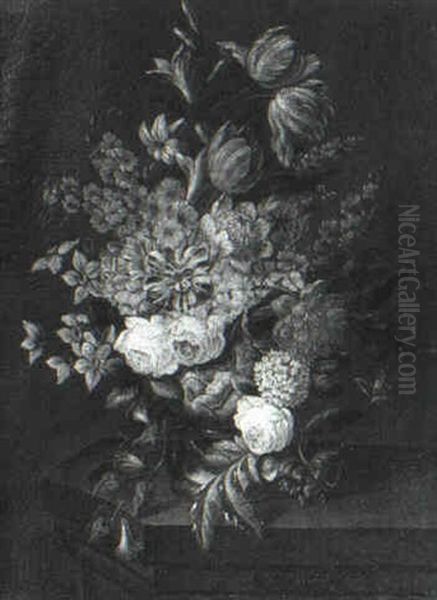
These prints served multiple purposes. They functioned as models for students and other artists, disseminating his style and approach to flower painting. They were invaluable resources for designers in various fields, including textiles, ceramics, and metalwork. Craftsmen could adapt Monnoyer's floral motifs for decorating a wide range of objects. The clarity and elegance of his engraved flowers made them particularly suitable for adaptation.
Indeed, his designs are known to have influenced the decoration of European porcelain, including the famous Meissen and Dresden factories in Germany, which were developing in the early 18th century, shortly after his death. The prints ensured that Monnoyer's influence extended far beyond the circles of those who could afford his paintings or tapestries, impacting the broader visual culture of the late Baroque and Rococo periods.
Family, Followers, and Attribution Issues
Artistic talent ran in the Monnoyer family. His son, Antoine Monnoyer (called 'Young Baptiste'), also became a flower painter, working in a style very similar to his father's. Antoine followed his father to London and continued to work there and later in Europe. Some sources suggest a degree of rivalry or tension between father and son, though details are obscure. The similarity in their styles, along with the work of other followers and imitators, has contributed to significant challenges in attributing unsigned works.
Jean-Baptiste Belin de Fontenay, another prominent flower painter who collaborated with Monnoyer on tapestry designs, became his son-in-law, further cementing the family's connection to the genre. Belin de Fontenay developed his own successful career, also receiving royal commissions.
The issue of attribution remains a complex aspect of Monnoyer scholarship. Because he did not consistently sign or date his works, and because his style was widely imitated (partly thanks to his influential prints), many paintings over the centuries have been incorrectly attributed to him. Some may be works by his son, Antoine, by Belin de Fontenay, or by other studio assistants or followers. Conversely, some works genuinely by Monnoyer may have been misattributed to others; the Chinese text mentions an instance involving William Hogarth, though this seems chronologically and stylistically unlikely and might reflect confusion in later provenance. Despite these scholarly challenges, a core body of work is securely attributed to Jean-Baptiste Monnoyer, firmly establishing his artistic identity and importance. Art historians continue to refine the catalogue of his works based on stylistic analysis and documentary evidence.
Legacy and Conclusion
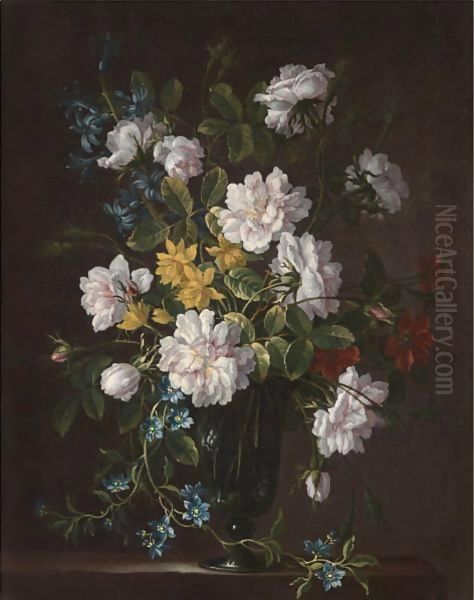
Jean-Baptiste Monnoyer died in London in 1699, leaving behind a rich legacy. He was undoubtedly one of the preeminent flower painters of the 17th century, mastering a genre that perfectly suited the decorative demands of the French Baroque court. His unique achievement lay in his ability to fuse meticulous botanical observation with a grand, decorative aesthetic. His paintings are celebrations of nature's beauty, rendered with technical brilliance and compositional flair.
His influence extended through his numerous commissions for royal palaces and aristocratic mansions in both France and England, through his crucial contributions to the prestigious Gobelins and Beauvais tapestry manufactories, and perhaps most widely, through his popular and enduring series of floral engravings. He elevated flower painting to a high art form within the decorative context of his time, influencing contemporaries like his son Antoine and son-in-law Belin de Fontenay, as well as subsequent generations of artists and designers across Europe.
While attribution issues persist for some works associated with his name, his reputation rests securely on the many magnificent paintings and designs that are undoubtedly his. From the opulent halls of Versailles to the pages of his engraved flower book, Jean-Baptiste Monnoyer's art continues to delight viewers with its vibrant depiction of floral abundance, embodying the splendour and artistic vitality of the Age of Louis XIV. His works remain highlights in major museum collections, including the Louvre, the Musée d'Orsay, the Metropolitan Museum of Art, the National Gallery in London, and many others, ensuring his enduring fame.